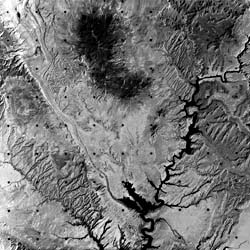 |
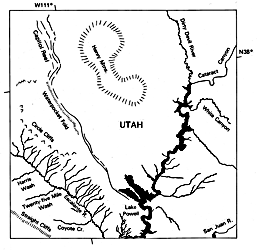 |
|---|---|
| Plate F-6 | Map |
 |
 |
|---|---|
| Plate F-6 | Map |
This Return-Beam Vidicon image shows the region of the Glen Canyon in south-central Utah. An extensive sedimentary sequence is exposed, including the Cretaceous sedimentary rocks along the Straight Cliffs escarpment of the Kaiparowits Plateau. The underlying Jurassic rocks include massive cliff-forming units of the Glen Canyon Group. Narrow sinuous bedrock canyons are especially well developed in the Glen Canyon Group, which includes the Navajo Sandstone. The Circle Cliffs expose underlying Triassic sandstone, shales, and conglomerate units (Figures F-6.1 and Figure F-6.2).
The Henry Mountains (Figure F-6.3) comprise a classic locality where Grove Karl Gilbert (1877) developed the concept of updoming of sedimentary rocks by laccolithic domes. As with other laccolithic mountains on the Colorado Plateau, doming is assumed to have occurred in the Early Miocene, about 25 million years ago (Hunt, 1956). Growth of the domes led to drainage adjustment. It is interesting that, while major rivers flow across folds, they tend to flow around the large igneous structures of the Colorado Plateau.
| Figure F-6.1 | Figure F-6.2 |
|---|---|
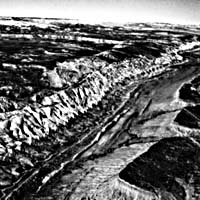 |
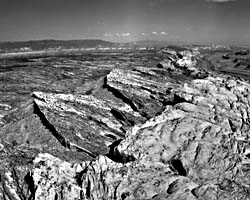 |
Cataract Canyon, in the upper right part of the scene, is a relatively low sinuosity section of the Colorado River where it crosses the crest of the broad Monument Upwarp. Because of flooding by Lake Powell below the Dirty Devil River Junction, the details of the Glen Canyon are difficult to discern along the mainstem Colorado. However, preimpoundment surveys reveal that the river gradient through Cataract Canyon is 1.9 m/km (10 ft/mi), changing to 0.3 m/km (1.5 ft/mi) in the Glen Canyon. The meandering patterns are associated with the gentler gradients, and the steeper gradients are associated with the cores of upwarps. One theory holds that these relationships derive from the antecedent history of the river (Hunt, 1969). According to this theory, the Colorado River in the later Tertiary and Quaternary was incising this part of the Colorado Plateau as various anticlinal folds and upwarps were growing. A relevant analogy is to a saw into which a log is being pushed. The saw represents the continuing cutting of a river, and the log represents growing folds.
This part of the Colorado Plateau contains numerous examples of natural bridges, alcoves, and arches. These are features of inner canyons along the Colorado Glen Canyon and major tributaries such as the Escalante River. These features are all presumably Pleistocene in age.
| Figure F-6.3 | Figure F-6.4 |
|---|---|
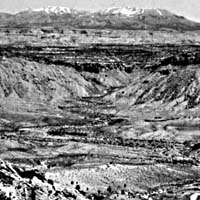 |
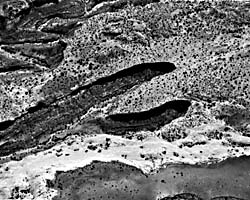 |
Valleys in the massive sandstones of the Colorado Plateau show steep-walled theater-like terminations (FigureF-6.4). Here, an excellent example is an unnamed canyon where ground-water seepage in the Navajo Sandstone contributes to the local disintegration of bedrock and subsequent backwearing of cliffs, a process termed "sapping." Spring sapping is the concentrated variant of the process in which ground-water outflow undermines slopes, generally along joint-and fault-controlled zones, resulting in the headward growth of valleys. Canyons formed by sapping have prominent structural control, vertical to overhanging walls, flat floors, elongate shape, low drainage density (leaving undissected uplands), relatively short tributaries to main trunk valleys, irregular variation in valley width as a function of valley length, and theater-like valley heads. Many of the Colorado Plateau sapping valleys are probably relict features, since lowered water tables and/or dessicating climatic conditions have probably resulted in reduced ground-water flow to the valley floors at present. During wetter climatic episodes of the Quaternary, probably coinciding with periods of mountain glaciation, spring sapping activity would have been more pronounced. Under modern climatic conditions, the results of past spring-sapping processes are obscured by the modifying action of nonsapping morphogenetic processes. Landsat 30914-17091-A, September 4, 1980.
Continue to Plate F-7| Chapter 4 Table of Contents.| Return to Home Page| Complete Table of Contents|